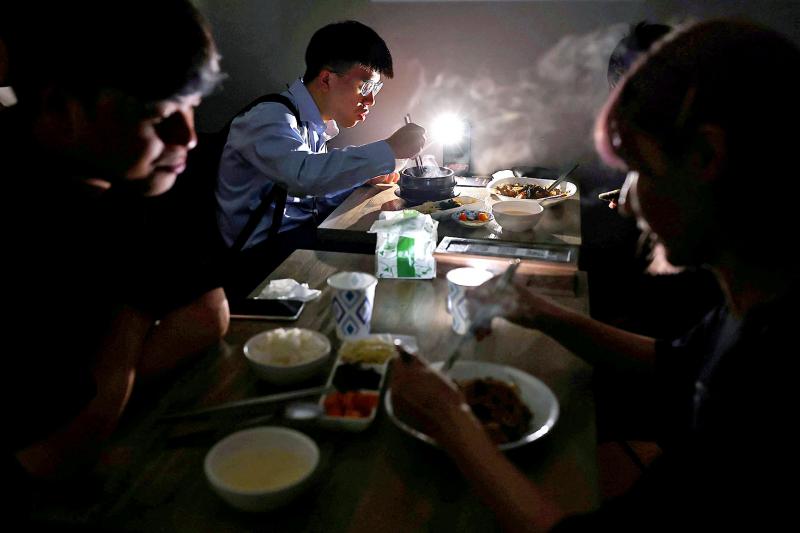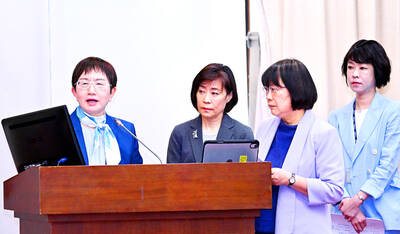Two blackouts in the span of a week this month have reignited debates over the government’s energy transition policy, raising fears that the nation is facing a power shortage crisis.
Although the Bureau of Energy has said the blackouts are isolated incidents that highlight the need to improve grid resilience, critics say the reasons for the blackouts are much simpler: Taiwan is not producing enough power and the problem will only worsen in the coming years.
The May 13 blackout, which caused more than 4 million households to lose power on a rotational basis for five hours, came as Taiwan Power Co’s (台電, Taipower) Web site showed that the nation’s grid was “green,” with more than 10 percent of operating reserve margin.

Photo: Ann Wang, Reuters
State-run Taipower declined to comment when asked if Taiwan’s electricity supply would remain stable.
“We are not responsible for setting the government’s policies, but to enact them,” Taipower spokesman Chang Ting-shu (張廷舒) said.
“Taipower was under political pressure to say they had 10 percent in operating reserve margin that day, but the fact that the power went out for five hours showed that they really did not,” said Chen Li-cheng (陳立誠), a retired energy consultant who used to head Gibson Engineers (吉興工程), a Taipei-based Taiwan-US engineering company.
Chen described the state-run utility as a “scapegoat.”
Although the May 13 blackout was said to have been due to an employee’s error, a second blackout on May 17 prompted Taipower to say that “unexpectedly high usage” was a factor in the power loss.
Taiwan’s energy usage has been accelerating along with economic growth, according to a Bureau of Energy report released earlier this month.
Last year, energy use increased 2.1 percent year-on-year, far above the 10-year average. With a hot economy and hotter summers, annual energy use is projected to increase by an average of 2.5 percent per year through 2027.
At the same time, President Tsai Ing-wen’s (蔡英文) energy transition policy calls for nuclear energy to be phased out by about 2025, and for coal to be reduced in the nation’s energy mix. According to the plan, by 2025, Taiwan would derive 20 percent of its electricity from renewable sources, 50 percent from liquefied natural gas (LNG) and only 30 percent from coal.
Liang Chi-yuan (梁啟源), who was a minister without portfolio in charge of energy from 2009 to 2011 under former president Ma Ying-jeou (馬英九), said the Tsai administration’s plan to drop nuclear power in favor of renewables and LNG would lead to power shortages, adding that the bureau’s report showed that reserve margin would fall to 7.7 percent in 2023, well below the 10 percent “green” range.
“The Tsai policy to cut out nuclear power would cause a decrease in power supply stability, an increase in prices and a growth in greenhouse gases,” he said.
However, Bureau of Energy Deputy Director-General Lee Chun-li (李君禮) disagrees.
“It is true that we will have some tight years as our LNG receiving capacity comes online, but being in a ‘yellow’ alert is not the same as ‘running out of power,’” Lee said.
The two LNG receiving stations in Taiwan are running at 108 percent capacity, Lee added.
A third LNG receiving station, the fate of which hangs in the balance of a referendum in August, is already set to be delayed by two-and-a-half years as the project has been pushed further offshore to appease environmentalists who say the station would harm algal reefs off the coast of Taoyuan’s Datan Borough (大潭).
CPC Corp, Taiwan (台灣中油) also plans to expand the two existing LNG terminals, while Taipower builds two new terminals to support generator stations, Lee said.
“We have the LNG stations, but without the gas it is like a gun without bullets,” he said. “We need to build the receiving infrastructure so we have the gas to burn.”
In the worst-case scenario, if Taiwan’s power usage exceeds the bureau’s expectations, Taiwan still has an adequate stock of coal-fired plants that could be used in an emergency, Lee said.
“Right now we are limited in the use of those plants by rules against air pollution, but if worst comes to worst, we are faced with a choice,” he said.
Some critics have suggested extending the tenure of the second and third nuclear power plants to contribute to power supply, but Lee said the idea is a nonstarter, as those plants are at the end of their tenure and there is also nowhere to store nuclear waste.
Although the government’s energy transition plan “will bring a difficult period,” it is worth doing, Lee said.
“We can’t keep doing things the old way forever,” he said.

‘SWASTICAR’: Tesla CEO Elon Musk’s close association with Donald Trump has prompted opponents to brand him a ‘Nazi’ and resulted in a dramatic drop in sales Demonstrators descended on Tesla Inc dealerships across the US, and in Europe and Canada on Saturday to protest company chief Elon Musk, who has amassed extraordinary power as a top adviser to US President Donald Trump. Waving signs with messages such as “Musk is stealing our money” and “Reclaim our country,” the protests largely took place peacefully following fiery episodes of vandalism on Tesla vehicles, dealerships and other facilities in recent weeks that US officials have denounced as terrorism. Hundreds rallied on Saturday outside the Tesla dealership in Manhattan. Some blasted Musk, the world’s richest man, while others demanded the shuttering of his

ADVERSARIES: The new list includes 11 entities in China and one in Taiwan, which is a local branch of Chinese cloud computing firm Inspur Group The US added dozens of entities to a trade blacklist on Tuesday, the US Department of Commerce said, in part to disrupt Beijing’s artificial intelligence (AI) and advanced computing capabilities. The action affects 80 entities from countries including China, the United Arab Emirates and Iran, with the commerce department citing their “activities contrary to US national security and foreign policy.” Those added to the “entity list” are restricted from obtaining US items and technologies without government authorization. “We will not allow adversaries to exploit American technology to bolster their own militaries and threaten American lives,” US Secretary of Commerce Howard Lutnick said. The entities

Minister of Finance Chuang Tsui-yun (莊翠雲) yesterday told lawmakers that she “would not speculate,” but a “response plan” has been prepared in case Taiwan is targeted by US President Donald Trump’s reciprocal tariffs, which are to be announced on Wednesday next week. The Trump administration, including US Secretary of the Treasury Scott Bessent, has said that much of the proposed reciprocal tariffs would focus on the 15 countries that have the highest trade surpluses with the US. Bessent has referred to those countries as the “dirty 15,” but has not named them. Last year, Taiwan’s US$73.9 billion trade surplus with the US

Prices of gasoline and diesel products at domestic gas stations are to fall NT$0.2 and NT$0.1 per liter respectively this week, even though international crude oil prices rose last week, CPC Corp, Taiwan (台灣中油) and Formosa Petrochemical Corp (台塑石化) said yesterday. International crude oil prices continued rising last week, as the US Energy Information Administration reported a larger-than-expected drop in US commercial crude oil inventories, CPC said in a statement. Based on the company’s floating oil price formula, the cost of crude oil rose 2.38 percent last week from a week earlier, it said. News that US President Donald Trump plans a “secondary